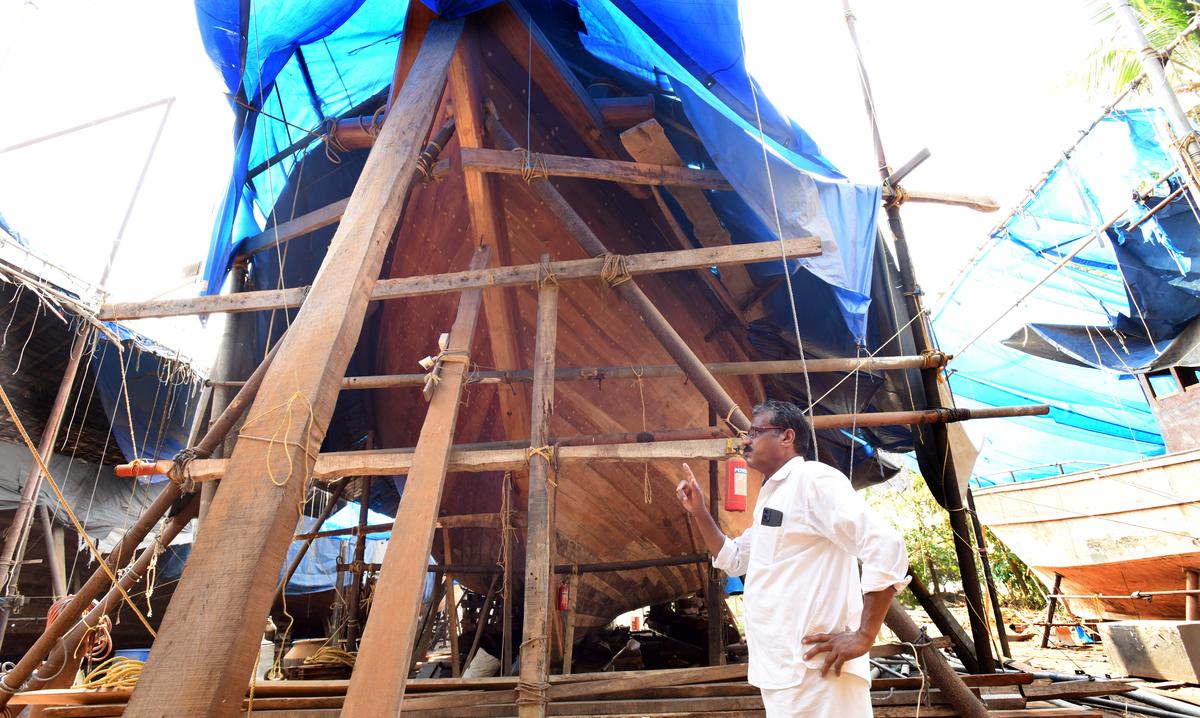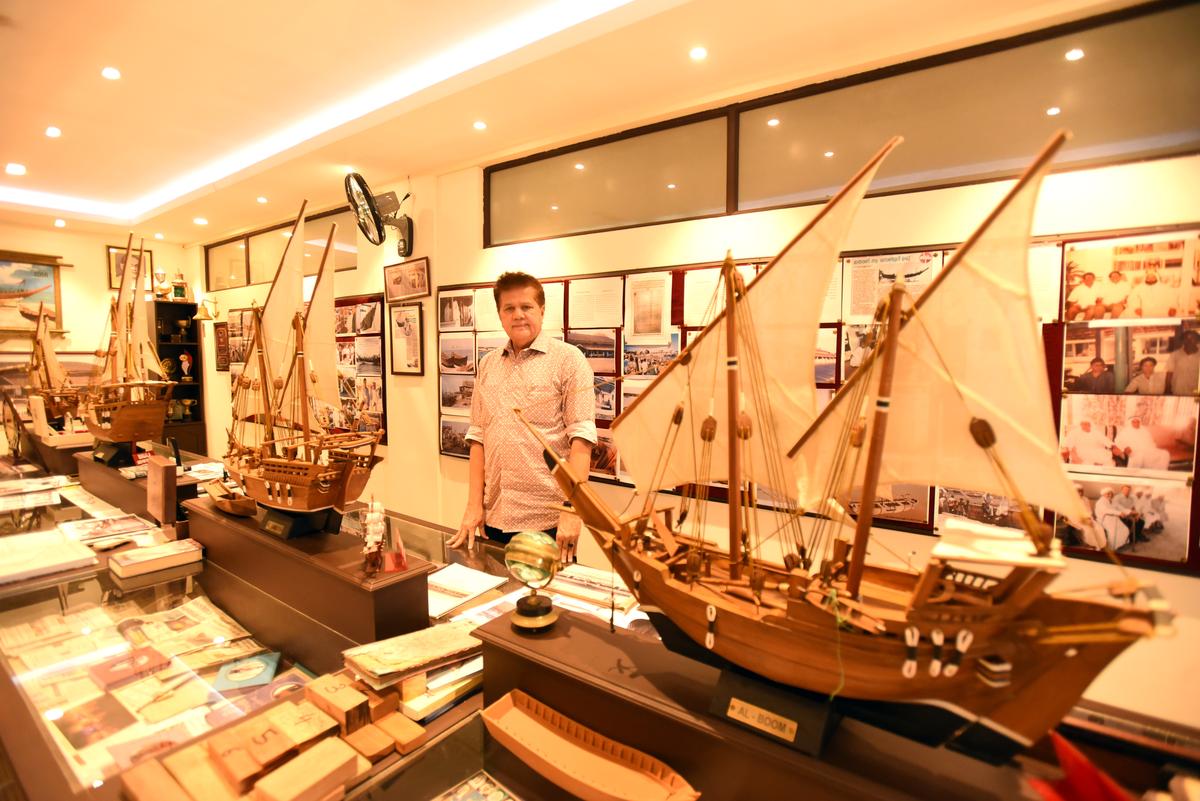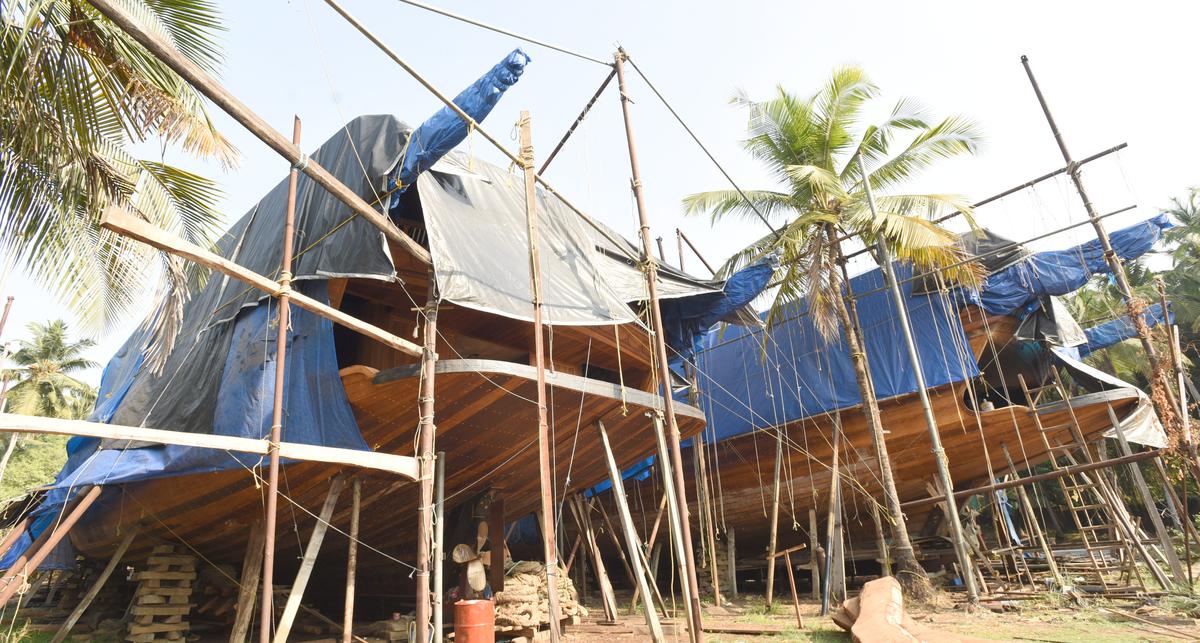[ad_1]
A warm summer evening breeze wafts through the workshop in Beypore, where two colossal wooden boats, nearly as tall as a coconut tree, tower over the workers resting on the floor. Through the labyrinth of wooden planks and thick ropes, Sathyan Edathodiyil, the master carpenter or maestiri, makes his way, carrying a jug of lemonade for the men.
Constructing the two vessels, or urus as the locals call them, has been challenging for the third-generation maestiri. The project, commissioned by a businessman in Qatar, should have taken less than two years, but has stretched to five — delayed by the 2018 Kerala floods and the pandemic. Now, with monsoon approaching, he has to wait a few more months to get the clearance to take the boats to Qatar.
An uru at the Beypore boat yard
| Photo Credit:
K. Ragesh
Urus are large wooden dhows (one- or two-masted ships) built by skilled artisans in Beypore, a sleepy town to the south of Kozhikode in Kerala. Built by hand using traditional methods passed down through generations, they were once highly sought-after trading vessels by Arab traders (India’s west coast had active trade relationships with the Middle East). While dhows are made in Salaya and Mandvi in Gujarat, and earlier in Mangaluru, the urus are renowned for their superior craftsmanship and durability.
“I am perhaps among the last five or six remaining carpenters with the full knowledge of making the craft,” says the 59-year-old. His white shirt and lungi are liberally dusted with wood shavings and stained with soil. His soft voice is dejected as he adds, “I don’t know what will happen after us.”
The urus are built without any blueprints
| Photo Credit:
K. Ragesh
No bride, no job security
Beypore, on the banks of the Chaliyar River, rose to prominence in boat-making in medieval times. The town’s superior craftspeople, availability of good quality timber from nearby forests, its location at a deep river mouth, and its proximity to the bustling Kozhikode port, which, under the rule of the Zamorins (from the 13th century) was a major hub of international trade, all helped.
Some historians argue that the Arabs, who were active seafarers with their own dhow-making traditions, introduced this particular style of ship-building to local Hindu craftsmen of the Asari community, who then further developed it indigenously. Its uniqueness is that the maestiris build the ships without blueprints. Traditional knowledge is passed on through apprenticeships. “But today there is no job security, or even a certificate if youngsters take it up,” says Edathodiyil, who has been building urus for over four decades. “They might not even get a bride if they become boat builders.”

Master carpenter Sathyan Edathodiyil
| Photo Credit:
K. Ragesh
His son didn’t want to follow his path and is pursuing chartered accountancy. Diversification could be a solution for the community. Also, as Edathodiyil states, “The government should do something to promote urus, and the communities associated with it.”
Success on the other side
Across the river, P.O. Hashim, who runs the only other uru-making yard in Beypore, has a different story to tell. His family business is doing well. There is a 100-ft uru anchored just outside his long yard, ready to set off for Qatar. Two smaller urus are nearly finished. The latter is his innovation — to expand to newer markets such as Europe, as they can be easily carried there on container ships.
A small uru at M/S Haji PI Ahmed Koya
| Photo Credit:
K. Ragesh
Sitting in his office, Hashim, 69, shares that helming the 140-year-old, family-run boat-building company is a matter of prestige. “At our peak, M/S Haji PI Ahmed Koya used to make 15 to 20 urus a year,” he says. This reduced when the demand for cargo urus declined. So, Hashim diversified. He saw an opportunity in making vessels for luxury and tourism. Today, he focuses on building urus with ornate designs for premium clients in Kuwait, Qatar, Bahrain, and Dubai. (Qatar became a major market in 2011 after the royal family commissioned urus.) According to industry sources, urus can cost over ₹5 crore, depending on its size and level of craftsmanship. The smallest uru made in his yard is 20 feet long and 4 feet tall, and the largest — used as a floating restaurant — is 140 feet long and 25 feet tall (more than half the length of a football field).
Hashim is also an ambassador for urus. He travels extensively in the Gulf region, gives interviews to Arab television, and has an active presence on Instagram. “I have got orders through them [social media],” he reveals. He has a first-of-its-kind private uru museum in the city and represents India at the International Dhow Festival in Qatar. One of his urus was showcased at the Cultural Village during the 2022 FIFA World Cup. But in the years to come, the industry will need a more concerted push to stay alive.

P.O. Hashim at his uru museum in Kozhikode
| Photo Credit:
K. Ragesh
A communal ecosystem
Uru making involves several communities. The businessmen (or agents, as they are called) have historically been Muslim, mostly of Arab ancestry, while the carpenters are Hindu. A unique community that is completely dependent on the uru industry is the Mappila Khalasis. Traditional dockyard workers and the second highest ranking members on a building yard, their expertise lies in moving weights and launching the boats on completion. “Currently, there are less than 20 of us. And all of them are around my age,” says Ummer Mooppan, who is in his 70s.
Need for private entrepreneurship
While wooden ships have disappeared from Indian coasts, there is still a thriving dhow industry in West Asia. DP World, Dubai, for instance, handles 1.3 million metric tonnes of goods through dhows annually. “Dhows are a greener and cheaper option to transport cargo, even for India,” says Krishna Prasad, a shipping professional with a Ph.D in modern dhow shipping and its relevance to India. “We can tap their potential if there is a push from the government.” Meanwhile, the Kozhikode District Tourism Promotion Council is trying to organise the carpenters to get the craft a GI tag.

Urus await transport at Beypore’s boat yards
| Photo Credit:
K. Ragesh
Private entrepreneurship is another solution. “In the 1990s, an entrepreneur spotted the potential of Kerala’s inland cargo boats. Now, houseboats are one of the most iconic things that defines the State’s tourism,” says Rajkumar K., CEO of Kerala Tourism Mart. “If entrepreneurs tapped into the potential of these historic boats, new possibilities could open up.”
Sailing from Kerala to Mecca
Maestiris use Indian teak to build the deck and other portions that stay above water, and imported Malaysian wood such as kwila and sal for the keel and everything that will get submerged (as good quality wood is scarce locally). “The tools and processes we follow are from the old times,” says Gokuld Das Edathumpadikkal, the head maestiri at Hashim’s yard. According to his family’s legends, it is said that one of his ancestors made the ship in which the Kerala king Cheraman Perumal travelled to Mecca after converting to Islam.
The writer is the co-founder of ARPO, an organisation that promotes culture and heritage.
[ad_2]
Source link





